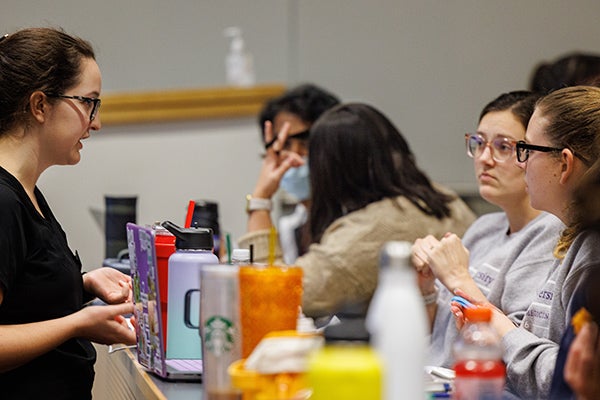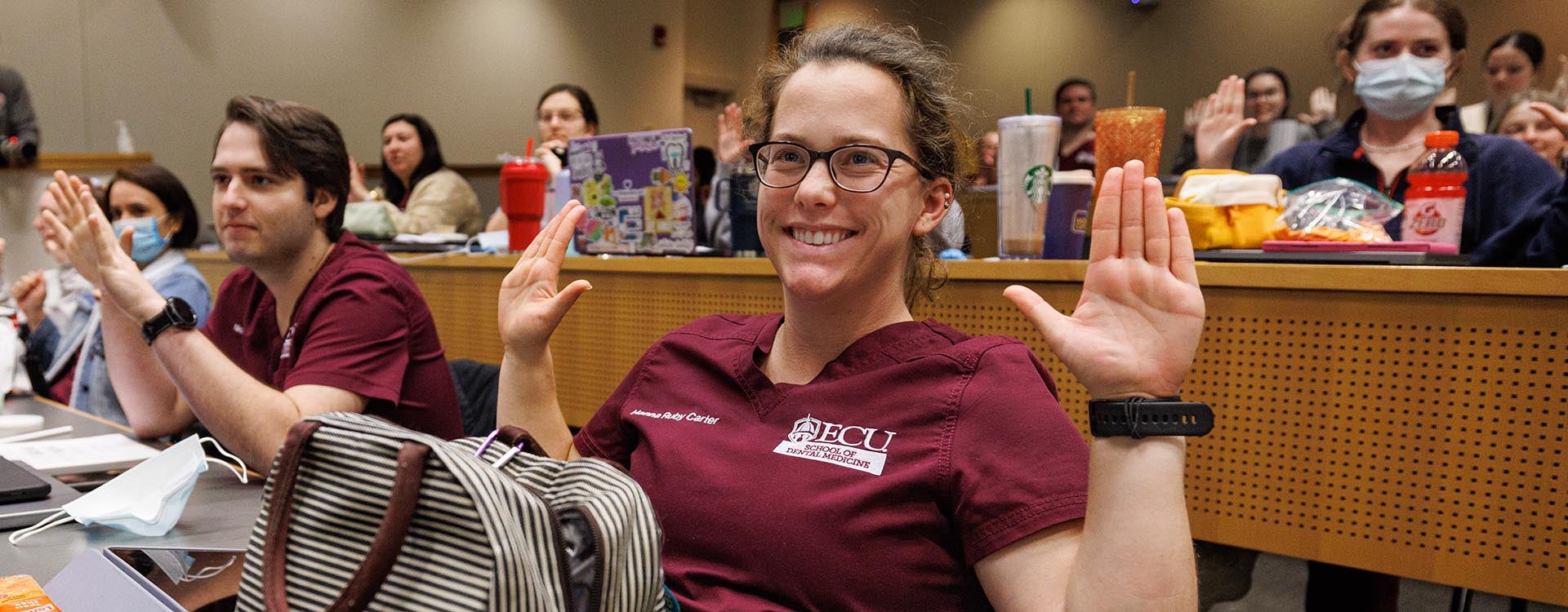Occupational therapy, dental students work to build hand strength, relationships
A two-minute walk across East Carolina University’s Health Sciences Campus was all it took for students to break down barriers and build interdisciplinary relationships.
On an overcast Thursday, eight second-year occupational therapy students from the College of Allied Health Sciences travelled to the School of Dental Medicine, where about four dozen first-year dental students quickly ate lunch. The OT students filed into a stadium classroom to become lecturers themselves and to teach their fellow Pirates how to train their hands to hold drills, probes and mirrors for hours on end without strain or injury.

East Carolina University occupational therapy students give dental students tips on exercises to strengthen their hands for the long hours they work with drills, probes and mirrors. (ECU photos by Cliff Hollis)
The occupational therapy students, under the direction of Lauren Turbeville, assistant professor, and Rachel Taylor, teaching instructor, started the training session with a quick overview of exercises and stretches for hand muscles and ligaments. Then they turned the dental students loose with pink and blue physical therapy putties that are used for stretching and strength-building. The OT students, in blue scrubs, then fanned out into a room full of maroon-scrubbed dental students to work one-on-one with their new health care partners.
First-year dental student Lativia Nash, from Caswell County, worked as a dental assistant before starting dental school and knew the challenge of laboring with hand tools for hours on end, particularly in the tiny mouths of the pediatric practice where she worked for four years.
The first question she asked when able to get one-on-one time with an OT student: If her hands start to cramp, should she stop working and stretch them? The answer was a resounding, “yes.”
“I’m grateful for them coming in and talking to us,” Nash said. “I learned some things, especially building the muscle in your hand and different techniques that we can use if our hands start to cramp up.”
Occupational therapy student and Greenville native Kelly Oglesby said she usually must consider the needs of a person who has had a stroke or other movement-limiting injury rather than a non-limited patient who is facing fatigue and repetitive stress injury — prevention of injury rather than recovery from one.
“The dental students have fully functioning hands. They don’t have a disability, but it’s important that we help them so that they can do their job longer,” Oglesby said. “As occupational therapists, that’s still important. Even though they may not have a physical disability, it’s just as important.”

A dental student uses therapy putty to practice hand strengthening exercises demonstrated by occupational therapy students.
One of the unforeseen benefits of getting students from different specialties in the same room to simply interact? Oglesby said that in speaking with the dental students, she learned about back and neck pain that come from dental students being hunched over patients all day. That got her thinking about further training to help the dental students limit back and next strain.
“We were focusing on fine motor, but they were also saying, ‘You know, we’re bent over all the time, like our neck start to hurt,’” Oglesby said. “It would be interesting to see how they are positioned when they’re working on their patients, because we could probably help with that too.”
Maggie Pafford, a clinical assistant professor and associate dean for student affairs at the School of Dental Medicine, said the curriculum for dental students has been stair-stepped to allow students to build hand strength over the four years of their education.
“During the D1 year, they will be in a simulated clinic about 20 percent of their time in the simulation lab with a handpiece of instruments in hand. Then during the D2 year, it may bump up to 50 percent, and by their third year maybe 60-70 percent,” Pafford said. “And then D4 it’s 100 percent of the time, they’ve got a handpiece in their hand. They’re seeing patients all the time. Endurance and correct ergonomics are key for harmony in this career.”
While the gradual buildup of strength through the years helps, Pafford believes that the tips and training the OT student brought to the dental school will help her students make an easier adjustment to the rigors of dental medicine.
Pafford said that there was momentum on the health sciences campus for interprofessional training and education before the COVID-19 pandemic hit, but social distancing requirements stifled some of the progress. The 45 minutes of OT-dental hand strengthening interaction is an example of things to come for interprofessional collaboration.
“Hopefully this is the start of a new season for interprofessional collaboration,” Pafford said.

ECU dental students practice hand stretching exercises taught by occupational therapy students.